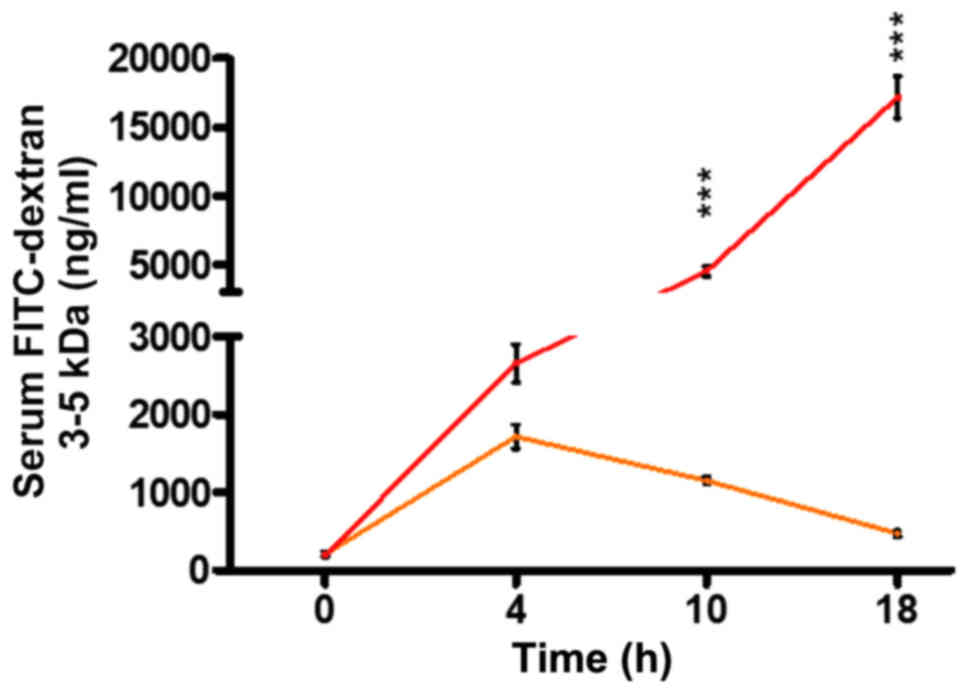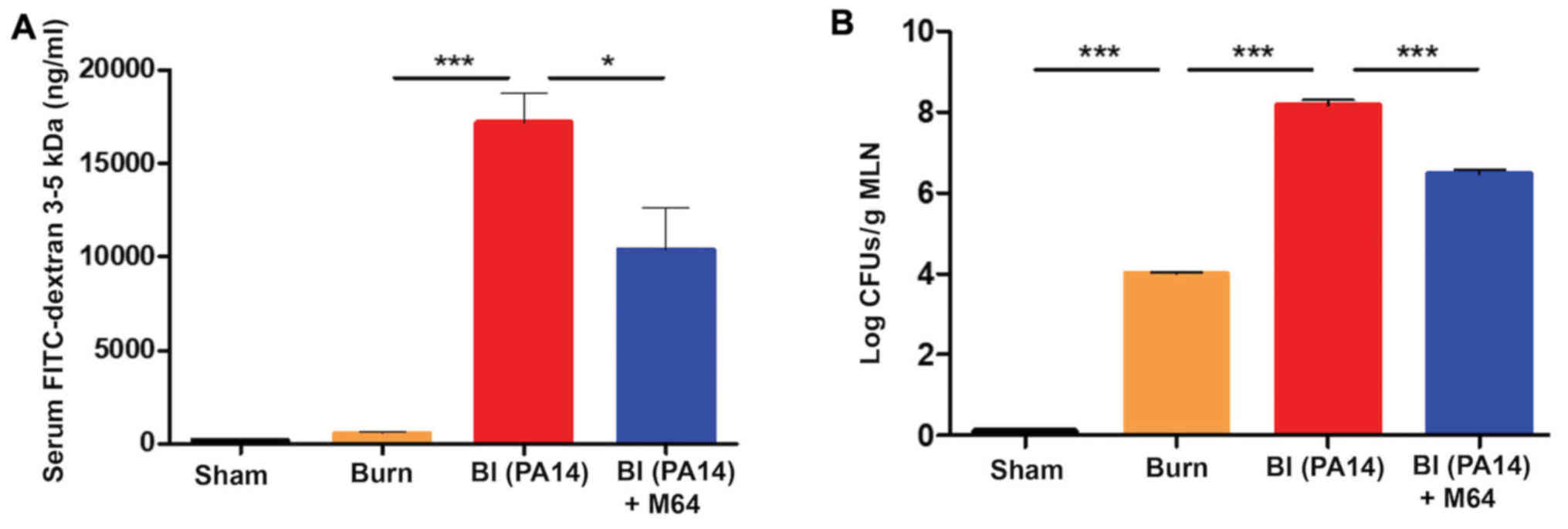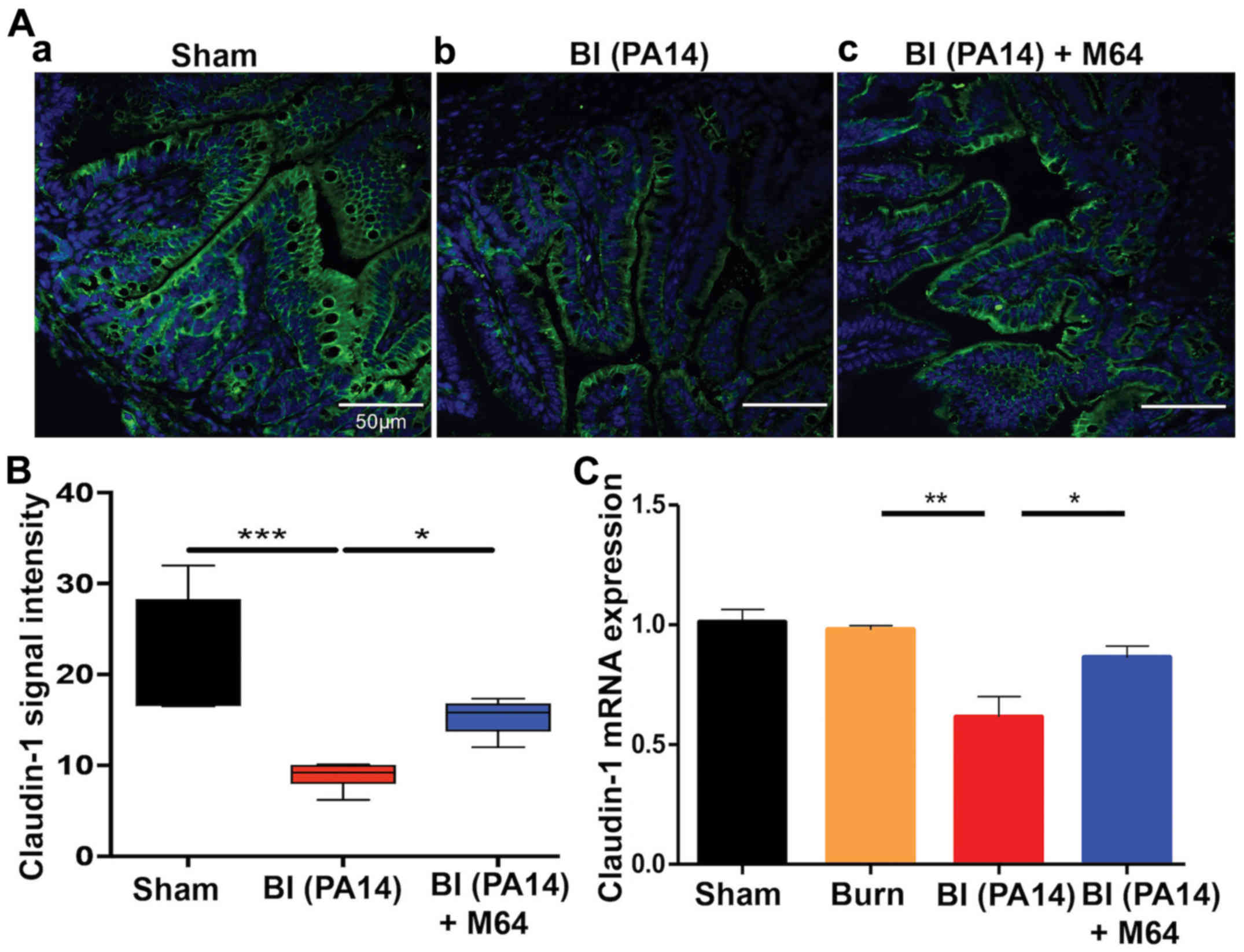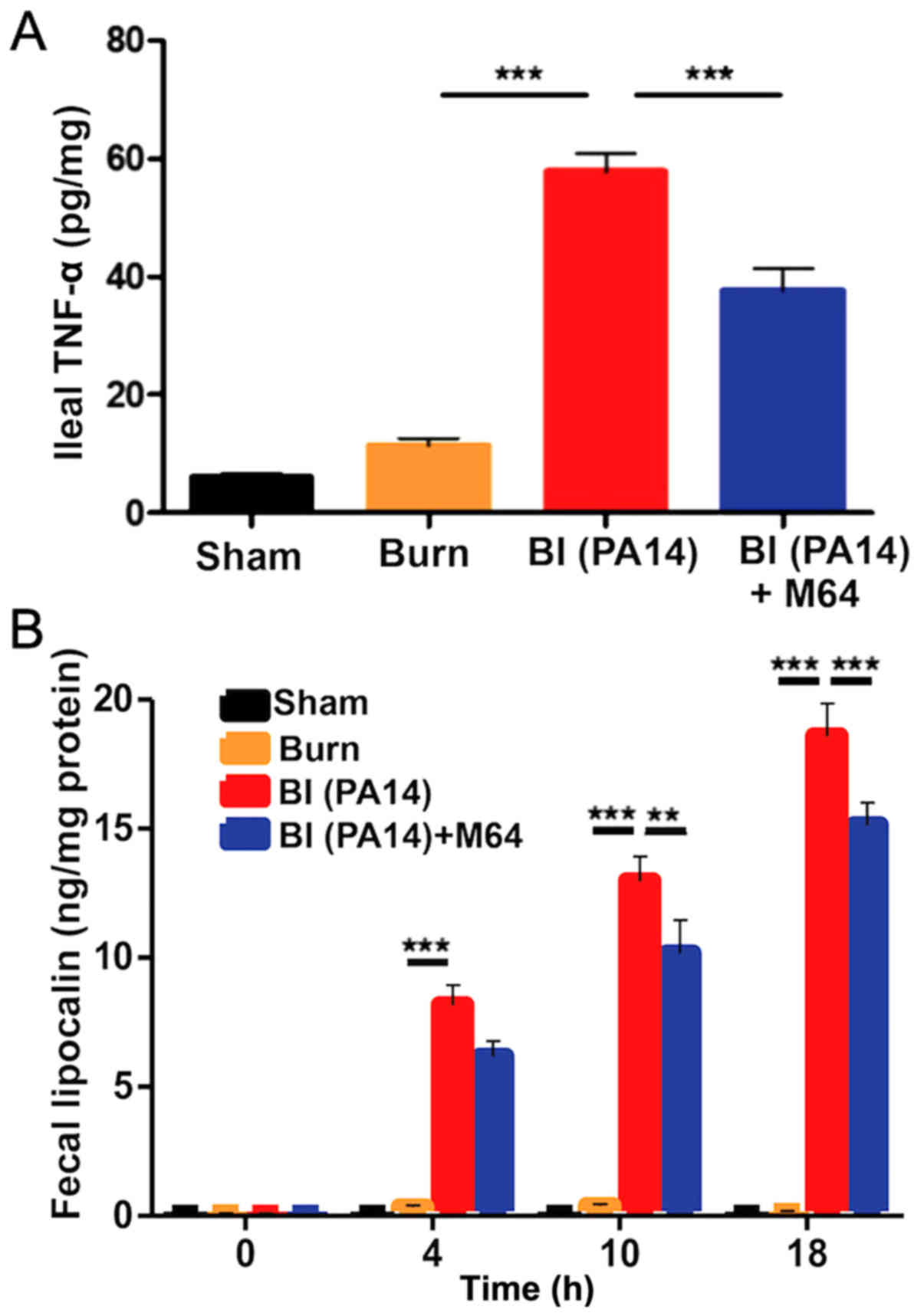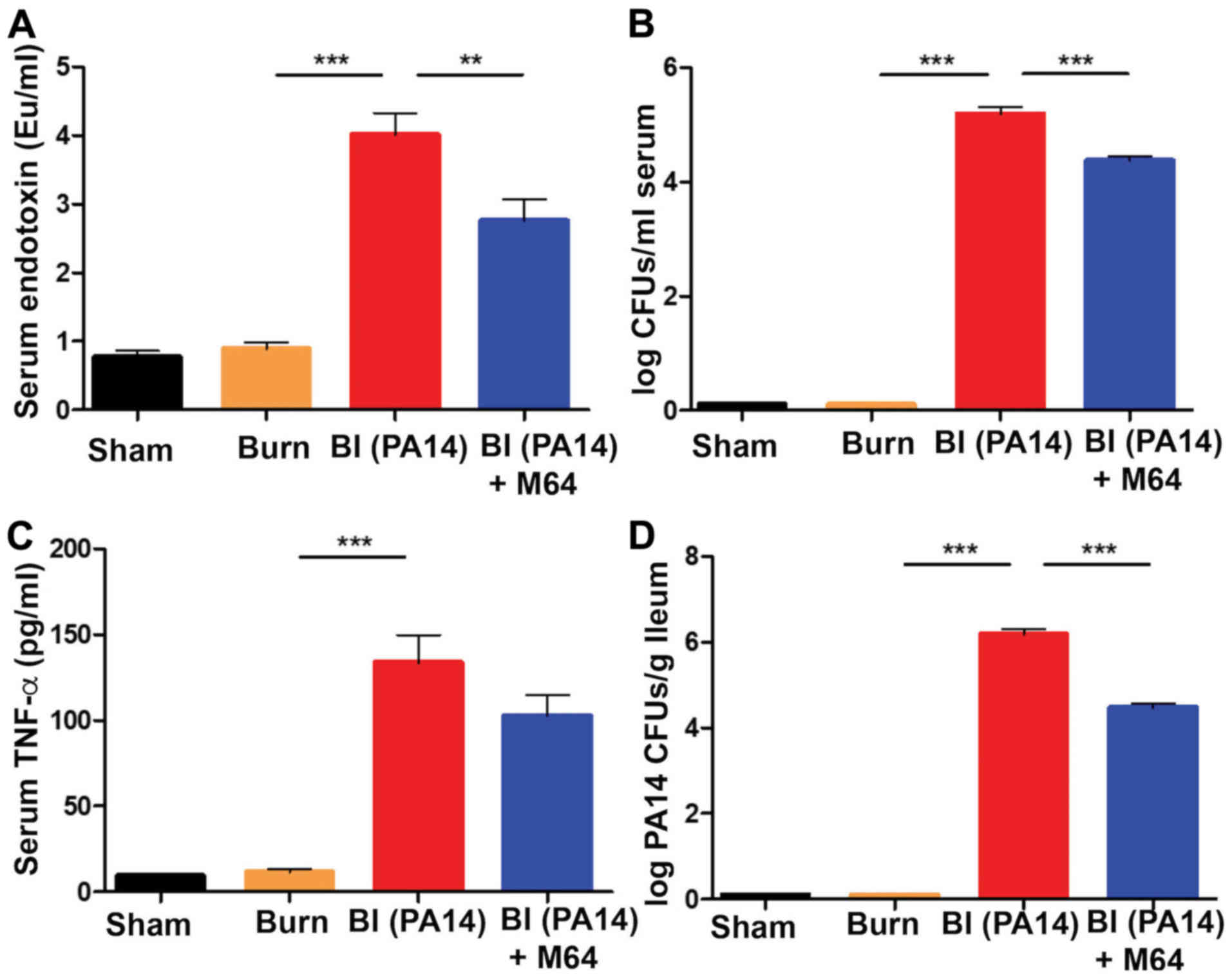|
1
|
Groschwitz KR and Hogan SP: Intestinal
barrier function: Molecular regulation and disease pathogenesis. J
Allergy Clin Immunol. 124:3–20. 2009. View Article : Google Scholar : PubMed/NCBI
|
|
2
|
Muniz LR, Knosp C and Yeretssian G:
Intestinal antimicrobial peptides during homeostasis, infection,
and disease. Front Immunol. 3:3102012. View Article : Google Scholar : PubMed/NCBI
|
|
3
|
Van Spaendonk H, Ceuleers H, Witters L,
Patteet E, Joossens J, Augustyns K, Lambeir AM, De Meester I, De
Man JG and De Winter BY: Regulation of intestinal permeability: The
role of proteases. World J Gastroenterol. 23:2106–2123. 2017.
View Article : Google Scholar : PubMed/NCBI
|
|
4
|
Forjuoh SN: Burns in low- and
middle-income countries: A review of available literature on
descriptive epidemiology, risk factors, treatment, and prevention.
Burns. 32:529–537. 2006. View Article : Google Scholar : PubMed/NCBI
|
|
5
|
Ryan CM, Yarmush ML, Burke JF and Tompkins
RG: Increased gut permeability early after burns correlates with
the extent of burn injury. Crit Care Med. 20:1508–1512. 1992.
View Article : Google Scholar : PubMed/NCBI
|
|
6
|
Nielson CB, Duethman NC, Howard JM,
Moncure M and Wood JG: Burns: Pathophysiology of systemic
complications and current management. J Burn Care Res.
38:e469–ee481. 2017. View Article : Google Scholar : PubMed/NCBI
|
|
7
|
Wolf SE, Ikeda H, Matin S, Debroy MA,
Rajaraman S, Herndon DN and Thompson JC: Cutaneous burn increases
apoptosis in the gut epithelium of mice. J Am Coll Surg. 188:10–16.
1999. View Article : Google Scholar : PubMed/NCBI
|
|
8
|
Costantini TW, Loomis WH, Putnam JG,
Drusinsky D, Deree J, Choi S, Wolf P, Baird A, Eliceiri B, Bansal V
and Coimbra R: Burn-induced gut barrier injury is attenuated by
phosphodiesterase inhibition: Effects on tight junction structural
proteins. Shock. 31:416–422. 2009. View Article : Google Scholar : PubMed/NCBI
|
|
9
|
Fazal N, Shelip A and Alzahrani AJ:
Burn-injury affects gut-associated lymphoid tissues derived CD4+ T
cells. Results Immunol. 3:85–94. 2013. View Article : Google Scholar : PubMed/NCBI
|
|
10
|
Earley ZM, Akhtar S, Green SJ, Naqib A,
Khan O, Cannon AR, Hammer AM, Morris NL, Li X, Eberhardt JM, et al:
Burn injury alters the intestinal microbiome and increases gut
permeability and bacterial translocation. PLoS One.
10:e01299962015. View Article : Google Scholar : PubMed/NCBI
|
|
11
|
Noble EE, Hsu TM and Kanoski SE: Gut to
brain dysbiosis: Mechanisms linking western diet consumption, the
microbiome, and cognitive impairment. Front Behav Neurosci.
11:92017. View Article : Google Scholar : PubMed/NCBI
|
|
12
|
Li N, Hu X, Liu Y, Wang Y, Wang Y, Liu J,
Cai W, Bai X, Zhu X, Han J and Hu D: Systemic inflammatory
responses and multiple organ dysfunction syndrome following skin
burn wound and Pseudomonas aeruginosa infection in mice. Shock.
40:152–159. 2013. View Article : Google Scholar : PubMed/NCBI
|
|
13
|
Ryan CM, Bailey SH, Carter EA, Schoenfeld
DA and Tompkins RG: Additive effects of thermal injury and
infection on gut permeability. Arch Surg. 129:325–328. 1994.
View Article : Google Scholar : PubMed/NCBI
|
|
14
|
Ziegler TR, Smith RJ, O'Dwyer ST, Demling
RH and Wilmore DW: Increased intestinal permeability associated
with infection in burn patients. Arch Surg. 123:1313–1319. 1988.
View Article : Google Scholar : PubMed/NCBI
|
|
15
|
Jones WG II, Barber AE, Minei JP, Fahey TJ
III, Shires GT III and Shires GT: Differential pathophysiology of
bacterial translocation after thermal injury and sepsis. Ann Surg.
214:24–30. 1991. View Article : Google Scholar : PubMed/NCBI
|
|
16
|
Yan S, Tsurumi A, Que YA, Ryan CM,
Bandyopadhaya A, Morgan AA, Flaherty PJ, Tompkins RG and Rahme LG:
Prediction of multiple infections after severe burn trauma: A
prospective cohort study. Ann Surg. 261:781–792. 2015. View Article : Google Scholar : PubMed/NCBI
|
|
17
|
Alp E, Coruh A, Gunay GK, Yontar Y and
Doganay M: Risk factors for nosocomial infection and mortality in
burn patients: 10 years of experience at a university hospital. J
Burn Care Res. 33:379–385. 2012. View Article : Google Scholar : PubMed/NCBI
|
|
18
|
Lister PD, Wolter DJ and Hanson ND:
Antibacterial-resistant Pseudomonas aeruginosa: Clinical impact and
complex regulation of chromosomally encoded resistance mechanisms.
Clin Microbiol Rev. 22:582–610. 2009. View Article : Google Scholar : PubMed/NCBI
|
|
19
|
Déziel E, Gopalan S, Tampakaki AP, Lépine
F, Padfield KE, Saucier M, Xiao G and Rahme LG: The contribution of
MvfR to Pseudomonas aeruginosa pathogenesis and quorum sensing
circuitry regulation: Multiple quorum sensing-regulated genes are
modulated without affecting lasRI, rhlRI or the production of
N-acyl-L-homoserine lactones. Mol Microbiol. 55:998–1014. 2005.
View Article : Google Scholar : PubMed/NCBI
|
|
20
|
Maura D, Hazan R, Kitao T, Ballok AE and
Rahme LG: Evidence for direct control of virulence and defense gene
circuits by the Pseudomonas aeruginosa quorum sensing regulator,
MvfR. Sci Rep. 6:340832016. View Article : Google Scholar : PubMed/NCBI
|
|
21
|
Allegretta G, Maurer CK, Eberhard J, Maura
D, Hartmann RW, Rahme L and Empting M: In-depth profiling of
MvfR-regulated small molecules in Pseudomonas aeruginosa after
quorum sensing inhibitor treatment. Front Microbiol. 8:9242017.
View Article : Google Scholar : PubMed/NCBI
|
|
22
|
Maura D, Drees SL, Bandyopadhaya A, Kitao
T, Negri M, Starkey M, Lesic B, Milot S, Déziel E, Zahler R, et al:
Polypharmacology approaches against the Pseudomonas aeruginosa MvfR
regulon and their application in blocking virulence and antibiotic
tolerance. ACS Chem Biol. 12:1435–1443. 2017. View Article : Google Scholar : PubMed/NCBI
|
|
23
|
Maura D and Rahme LG: Pharmacological
inhibition of the Pseudomonas aeruginosa MvfR Quorum-sensing system
interferes with biofilm formation and potentiates
antibiotic-mediated biofilm disruption. Antimicrob Agents
Chemother. 61(pii): e01362–17. 2017.PubMed/NCBI
|
|
24
|
Starkey M, Lepine F, Maura D,
Bandyopadhaya A, Lesic B, He J, Kitao T, Righi V, Milot S, Tzika A
and Rahme L: Identification of anti-virulence compounds that
disrupt quorum-sensing regulated acute and persistent
pathogenicity. PLoS Pathog. 10:e10043212014. View Article : Google Scholar : PubMed/NCBI
|
|
25
|
Rahme LG, Stevens EJ, Wolfort SF, Shao J,
Tompkins RG and Ausubel FM: Common virulence factors for bacterial
pathogenicity in plants and animals. Science. 268:1899–1902. 1995.
View Article : Google Scholar : PubMed/NCBI
|
|
26
|
Walker HL and Mason AD Jr: A standard
animal burn. J Trauma. 8:1049–1051. 1968. View Article : Google Scholar : PubMed/NCBI
|
|
27
|
Pasternak AJ, Hamonic GM, Van Kessel A and
Wilson HL: Postnatal regulation of MAMDC4 in the porcine intestinal
epithelium is influenced by bacterial colonization. Physiol Rep.
4(pii): e130182016. View Article : Google Scholar : PubMed/NCBI
|
|
28
|
Yu L, Zhai Q, Tian F, Liu X, Wang G, Zhao
J, Zhang H, Narbad A and Chen W: Potential of Lactobacillus
plantarum CCFM639 in protecting against aluminum toxicity mediated
by intestinal barrier function and oxidative stress. Nutrients.
8(pii): E7832016. View Article : Google Scholar : PubMed/NCBI
|
|
29
|
Livak KJ and Schmittgen TD: Analysis of
relative gene expression data using real-time quantitative PCR and
the 2(-Delta Delta C(T)) method. Methods. 25:402–408. 2001.
View Article : Google Scholar : PubMed/NCBI
|
|
30
|
Cani PD, Bibiloni R, Knauf C, Waget A,
Neyrinck AM, Delzenne NM and Burcelin R: Changes in gut microbiota
control metabolic endotoxemia-induced inflammation in high-fat
diet-induced obesity and diabetes in mice. Diabetes. 57:1470–1481.
2008. View Article : Google Scholar : PubMed/NCBI
|
|
31
|
Volynets V, Reichold A, Bardos G, Rings A,
Bleich A and Bischoff SC: Assessment of the intestinal barrier with
five different permeability tests in healthy C57BL/6J and BALB/cJ
mice. Dig Dis Sci. 61:737–746. 2016. View Article : Google Scholar : PubMed/NCBI
|
|
32
|
Gunzel D and Yu AS: Claudins and the
modulation of tight junction permeability. Physiol Rev. 93:525–569.
2013. View Article : Google Scholar : PubMed/NCBI
|
|
33
|
Markov AG, Veshnyakova A, Fromm M, Amasheh
M and Amasheh S: Segmental expression of claudin proteins
correlates with tight junction barrier properties in rat intestine.
J Comp Physiol B. 180:591–598. 2010. View Article : Google Scholar : PubMed/NCBI
|
|
34
|
Michielan A and D'Inca R: Intestinal
permeability in inflammatory bowel disease: Pathogenesis, clinical
evaluation, and therapy of leaky gut. Mediators Inflamm.
2015:6281572015. View Article : Google Scholar : PubMed/NCBI
|
|
35
|
Bruewer M, Luegering A, Kucharzik T,
Parkos CA, Madara JL, Hopkins AM and Nusrat A: Proinflammatory
cytokines disrupt epithelial barrier function by
apoptosis-independent mechanisms. J Immunol. 171:6164–6172. 2003.
View Article : Google Scholar : PubMed/NCBI
|
|
36
|
Chassaing B, Srinivasan G, Delgado MA,
Young AN, Gewirtz AT and Vijay-Kumar M: Fecal lipocalin 2, a
sensitive and broadly dynamic non-invasive biomarker for intestinal
inflammation. PLoS One. 7:e443282012. View Article : Google Scholar : PubMed/NCBI
|
|
37
|
Zhang Q, Raoof M, Chen Y, Sumi Y, Sursal
T, Junger W, Brohi K, Itagaki K and Hauser CJ: Circulating
mitochondrial DAMPs cause inflammatory responses to injury. Nature.
464:104–107. 2010. View Article : Google Scholar : PubMed/NCBI
|
|
38
|
Teplitz C, Davis D, Mason AD Jr and
Moncrief JA: Pseudomonas burn wound sepsis. I pathogenesis of
experimental Pseudomonas burn wound sepsis. J Surg Res. 4:200–216.
1964. View Article : Google Scholar : PubMed/NCBI
|
|
39
|
Teplitz C, Davis D, Walker HL, Raulston
GL, Mason AD Jr and Moncrief JA: Pseudomonas burn wound sepsis. Ii
hematogenous infection at the junction of the burn wound and the
unburned hypodermis. J Surg Res. 4:217–222. 1964. View Article : Google Scholar : PubMed/NCBI
|
|
40
|
Lesic B, Lépine F, Déziel E, Zhang J,
Zhang Q, Padfield K, Castonguay MH, Milot S, Stachel S, Tzika AA,
et al: Inhibitors of pathogen intercellular signals as selective
anti-infective compounds. PLoS Pathog. 3:1229–1239. 2007.
View Article : Google Scholar : PubMed/NCBI
|
|
41
|
Williams JM, Duckworth CA, Burkitt MD,
Watson AJ, Campbell BJ and Pritchard DM: Epithelial cell shedding
and barrier function: A matter of life and death at the small
intestinal villus tip. Vet Pathol. 52:445–455. 2015. View Article : Google Scholar : PubMed/NCBI
|
|
42
|
Williams JM, Duckworth CA, Watson AJ, Frey
MR, Miguel JC, Burkitt MD, Sutton R, Hughes KR, Hall LJ, Caamaño
JH, et al: A mouse model of pathological small intestinal
epithelial cell apoptosis and shedding induced by systemic
administration of lipopolysaccharide. Dis Model Mech. 6:1388–1399.
2013. View Article : Google Scholar : PubMed/NCBI
|
|
43
|
Cannon AR, Akhtar S, Hammer AM, Morris NL,
Javorski MJ, Li X, Kennedy RH, Gamelli RL and Choudhry MA: Effects
of mesalamine treatment on gut barrier integrity after burn injury.
J Burn Care Res. 37:283–292. 2016. View Article : Google Scholar : PubMed/NCBI
|
|
44
|
Samonte VA, Goto M, Ravindranath TM, Fazal
N, Holloway VM, Goyal A, Gamelli RL and Sayeed MM: Exacerbation of
intestinal permeability in rats after a two-hit injury: Burn and
Enterococcus faecalis infection. Crit Care Med. 32:2267–2273. 2004.
View Article : Google Scholar : PubMed/NCBI
|
|
45
|
Capaldo CT and Nusrat A: Cytokine
regulation of tight junctions. Biochim Biophys Acta. 1788:864–871.
2009. View Article : Google Scholar : PubMed/NCBI
|
|
46
|
Ma TY, Iwamoto GK, Hoa NT, Akotia V,
Pedram A, Boivin MA and Said HM: TNF-alpha-induced increase in
intestinal epithelial tight junction permeability requires NF-kappa
B activation. Am J Physiol Gastrointest Liver Physiol.
286:G367–G376. 2004. View Article : Google Scholar : PubMed/NCBI
|















